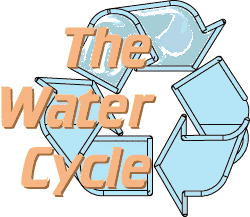![]()
![]()
Introduction

Introduction
Precipitation, evaporation, and transpiration are all terms that sound familiar, yet may not mean much to you. They are all part of the water cycle, a complex process that not only gives us water to drink, fish to eat, but also weather patterns that help grow our crops.
 Water is an integral part of life on this planet. It is an
odourless, tasteless, substance that covers more than three
quarters of the Earth's surface. Most of the water on Earth,
97% to be exact, is salt water found in the oceans. We can
not drink salt water or use it for crops because of the salt
content. We can remove salt from ocean water, but the
process is very expensive.
Water is an integral part of life on this planet. It is an
odourless, tasteless, substance that covers more than three
quarters of the Earth's surface. Most of the water on Earth,
97% to be exact, is salt water found in the oceans. We can
not drink salt water or use it for crops because of the salt
content. We can remove salt from ocean water, but the
process is very expensive.
Only about 3% of Earth's water is fresh. Two percent of the earth's water (about 66% of all fresh water) is in solid form, found in ice caps and glaciers. Because it is frozen and so far away, the fresh water in ice caps is not available for use by people or plants. That leaves about 1% of all the Earth's water in a form useable to humans and land animals. This fresh water is found in lakes, rivers, streams, ponds, and in the ground. (A small amount of water is found as vapour in the atmosphere.)